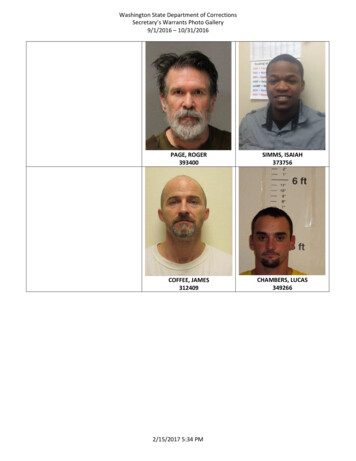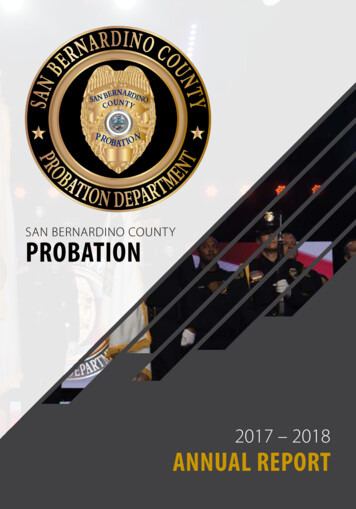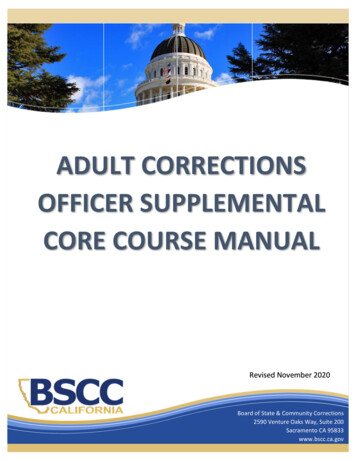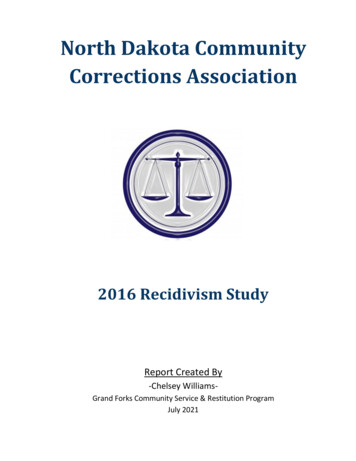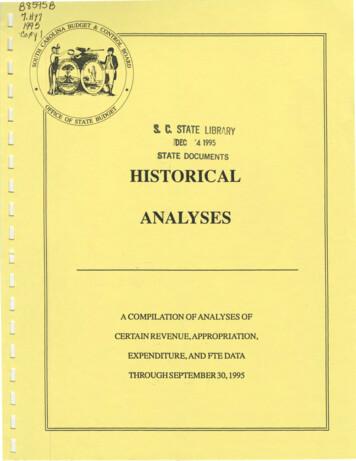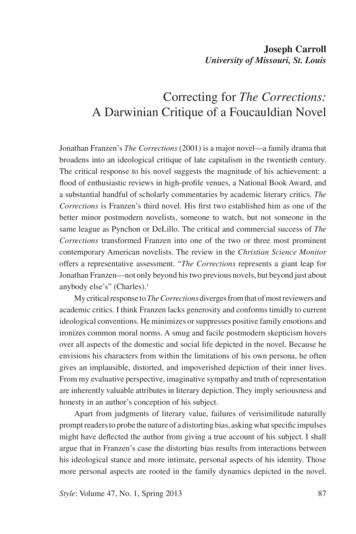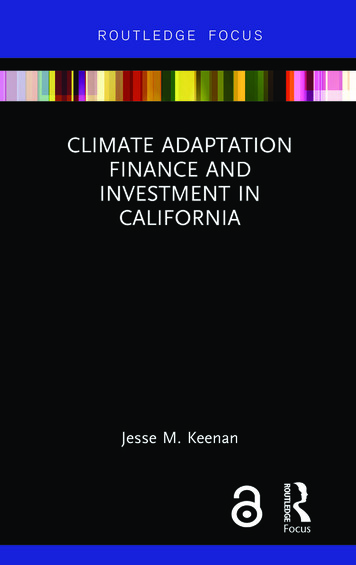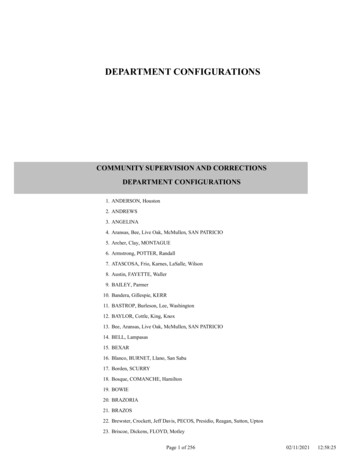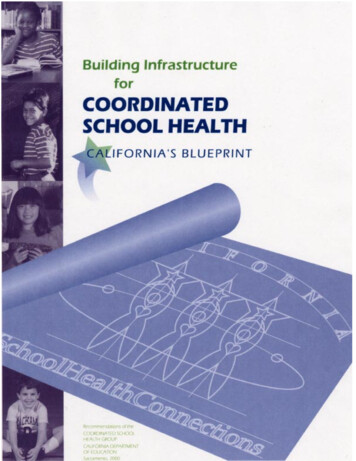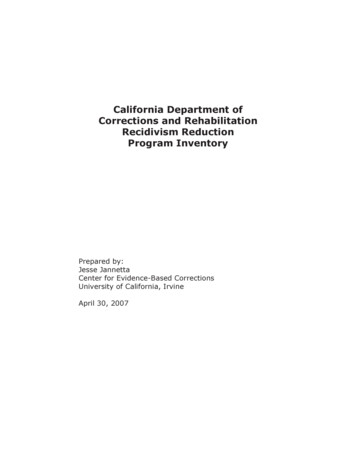
Transcription
California Department ofCorrections and RehabilitationRecidivism ReductionProgram InventoryPrepared by:Jesse JannettaCenter for Evidence-Based CorrectionsUniversity of California, IrvineApril 30, 2007
ContentsIntroduction - 2Prison Programs - 4Academic Courses - 4Bridging Education Program (BEP) - 6Carpentry Pre-Apprenticeship Program - 8Community Prisoner Mother Program (CPMP) - 9Conflict Anger Lifelong Management (CALM) - 11Drug Treatment Furlough - 13Elementary Secondary Education Act (ESEA) - 15Family Foundations Program (FFP) - 17Inmate Employability Program (IEP) - 19Offender Employment Continuum (OEC) - 21Re-Entry Education - 23S.T.A.N.D. U.P. (Successful Transitions and New Directions Utilizing Partnerships) - 25Substance Abuse Programs (SAP’s) - 27Amity Foundation at R. J. Donovan Correctional Facility - 29Center Point at California Institution for Men - 31CiviGenics, Inc. Correctional Recovery Academy - 33Mental Health Systems, Inc.—AMEND - 36Phoenix House – CSP Corcoran - 38Walden House -California Substance Abuse Treatment Facility,Yard F - 40Transitional Treatment Program (TTP) - 43Vocational Education - 45Parole Programs - 46Community-Based Coalition (CBC) - 46Community Re-Entry Partnerships (CRP) - 48Computer Literacy Learning Centers (CLLC) - 50Day Reporting Center (DRC) - 52Employment Development Department (EDD) Program - 55Female Offender Treatment and Employment Program (FOTEP) - 56In-Custody Drug Treatment Program (ICDTP) - 58Parolee Employment Program (PEP) - 60Parolee Service Centers (PSC) - 61Parolee Services Network (PSN) - 63Parolee Substance Abuse Program (PSAP) - 65Residential Multi-Service Center (RMSC) - 67Substance Abuse Service Coordinating Agency (SASCA) - 69Substance Abuse Treatment and Recovery (STAR) - 70Prison and Parole Programs - 72Employment Re-Entry Partnership (ERP) - 72Incarcerated Youthful Offenders (IYO) - 74Senate Bill 618 - 76Transitional Case Management Program-HIV - 78Transitional Case Management Program-Mental Health Services Continuum(TCMP-MHSCP) - 80Appendix I: Program Locations - 82Program Location by Institution - 83Program Location by County - 86Appendix II: Survey for the CDCR Offender Risk Reduction Program Inventory andCPAP Assessment - 891
CDCR Recidivism Reduction Program InventoryIntroductionThe CDCR Recidivism Reduction Program Inventory is a catalog of California Departmentof Corrections and Rehabilitation (CDCR) recidivism-reduction programming for adultoffenders as of March, 2007. This document was prepared by the Center for Evidence-BasedCorrections under the direction of the CDCR Expert Panel on Adult Offender Reentry andRecidivism Reduction Programs, and its contents are summarized in A Roadmap for EffectiveOffender Programming in California: Report to the California State Legislature, releasedJune 29, 2007.The Inventory provides detail on the goals, capacity, eligible population, program content,extent of evaluation, and other core attributes for all adult offender recidivism reductionprograms operated in CDCR institutions or through adult parole. No such catalog ofCDCR adult rehabilitative programming existed prior to the creation of the Inventory.Creation of this comprehensive, standardized and descriptive portrait of CDCR recidivismreduction programs is a necessary first step to understanding and evaluating the CDCR’sprogrammatic approach to rehabilitation of inmates and parolees.In order to be included in the Recidivism Reduction Program Inventory, a program had tomeet three criteria:1. It must conform to the definition of a program. A program is a set of structured servicesdesigned to achieve specific goals and objectives for specific individuals over a specificperiod of time. Programs are typically targeted towards particular problems such assubstance abuse or criminal thinking.a Assessment and referral mechanisms are crucialparts of a rehabilitative system, but are not themselves programs under our definition,and are not included in the Inventory.2. It must be a risk reduction program, intended to reduce risk factors associated withantisocial behavior of offenders, and thus make them less likely to commit furthercriminal offenses. The mandate for the Expert Panel, as described in California’sAmended Budget Act of 2006, is confined to those programs “designed to reducerecidivism.” Risk reduction programs are those programs that would be judgedsuccessful, or not, based on their impact on recidivism by participants. Risk reductionprograms are distinct from activity programs, which aim to occupy the time of anaThis program definition was taken from the Pennsylvania Department of Corrections “ProgramAnalysis: A Description of PA DOC Programs and an Evaluation of their Effectiveness.” Their work onprogram description and assessment is recognized as a national model, and was recommended as amodel for our work by Expert Panel member Jeffrey Beard.2
Introductionoffender, stimulate them, or engage them in pro-social activity to ease their adjustmentto institutional custody or parole supervision. They are also distinct from controlprograms, which are designed to increase offender compliance with conditions ofconfinement or supervision, or to more quickly, reliably and efficiently detect andrespond to lack of compliance. b3. It must be a CDCR-operated or funded program. The Inventory consists only ofprograms which the CDCR provides directly, or funds through contract providers. Theseare the programs for which CDCR should be held accountable for consistency and qualityof provision.The initial roster of programs to be considered for inclusion in the Inventory was compiledby the CDCR Office of Research in November of 2006. That roster, along with the criteriafor inclusion in the Inventory, were circulated among the management of the CDCR in theareas of adult programs, adult institutions, adult parole, substance abuse treatment andcorrectional education, among others, in early March of 2007. CDCR managers were askedto review the roster and the criteria, nominate programs that met the criteria but werenot included on the roster, and circulate the information to any other parties who might beaware of further programs. All nominations for inclusion in the Inventory were returned byMarch 20, 2007.The CEBC Program Review team developed a survey instrument to collect information oneach of the programs that met the Inventory inclusion criteria. (See Appendix II for a copyof the survey.) The survey drew from the approach to program review developed by thePennsylvania Department of Corrections (2003) and the five key program elements outlinedin Krisberg (1980). The surveys were distributed to program directors starting March 1,2007, along with a cover letter from Marisela Montes, CDCR Chief Deputy Secretary forAdult Programs and Chair of the Expert Panel. For programs operated at multiple sitesby multiple providers, CDCR program management staff nominated program sites to besurveyed, based on which sites they believed to be most representative of the “pure”program model. In addition, one in-prison Substance Abuse Program (SAP) was surveyedfor each of the six providers. There is inevitably some site to site variation within programs,but this survey method should provide a generally accurate representation of how eachprogram operates.ReferencesCalifornia Department of Corrections and Rehabilitation Expert Panel on Adult OffenderReentry and Recidivism Reduction Programs (2007). Report to the California StateLegislature: A Roadmap for Effective Offender Programming in California. CaliforniaDepartment of Corrections and Rehabilitation: Sacramento, CA.Krisberg, Barry (1980). “The Utility of Process Evaluation: Crime and Delinquency Programs”in Malcolm Klein and Kathy Teilman (ed.) Handbook of Criminal Justice Evaluation. SagePublications: Newbury Park, CA.Pennsylvania Department of Corrections, Division of Planning, Research, Statistics andGrants (2003). Program Analysis: A Description of PA DOC Programs and an Evaluation oftheir Effectiveness. Pennsylvania Department of Corrections: Harrisburg, PA.bIt is possible for a program to combine elements of all three program types.3
CDCR Recidivism Reduction Program InventoryPrison ProgramsAcademic CoursesCDCR’s Academic Courses constitute a competency-based classroom education programfor inmates without a high school diploma. Courses are divided into Adult Basic Education(ABE), English as a Second Language (ESL), and High School/GED. Instruction is providedby the CDCR Office of Correctional Education.Program Type: Academic educationProgram Goals: Reduce recidivism by providing inmates with the academic skills to function in societyProgram Location: Academic courses are offered at all 33 CDCR adult institutionsProgram Capacity: 11,529 (427 classrooms, 27 students per classroom)Commencement Date: 1980Eligibility and Admissions: All inmates without a high school diploma are eligible forCDCR academic courses, unless they are classified as extremely high risk or have medicalcircumstances that prevent them from participating. Students that speak a first languageother than English and have a reading grade level of 0 to 3.0, and are not able to speak,read or write in the English language are eligible for placement in ESL courses. Studentswith reading grade levels between 3 and 9 are eligible for Adult Basic Education (ABE) andstudents with reading grade levels between 9 and 12 are eligible for GED courses. TheInstitutional Classification Committee assigns inmates to the program waiting list, fromwhich inmates enter the class.Program Components: Individualized classroom instruction covering: Arithmetic Reading and literacy Written expression Life skills Science Social studies4
PRISON PROGRAMSService Delivery Mode: Individualized classroom instruction utilizing group activities,lectures and self-paced assignmentsIntensity/Duration: Class sessions are 6.5 hours a day, five days a week. It may take aninmate several years to advance through the academic course offerings, depending on his/her starting academic level and degree of motivation.Program progression and completion: English as a Second Language (ESL)Adult Basic Education (ABE) I, II, and IIIGeneral Equivalency Diploma (GED) and High SchoolA student progresses from one academic level to the next by meeting all the competenciesfor that level. Students successfully complete the CDCR academic program upon passing theOfficial GED Test as determined by the American Council on Education.Continuities with other programs and the community: NoneProgram evaluation: The CDCR academic program has not been evaluated, and noevaluation is currently planned.5
CDCR Recidivism Reduction Program InventoryBridging Education Program (BEP)BEP is a distance education program offered by the CDCR Office of Correctional Educationfor inmates who are waiting for assignment to academic education, vocational education, asubstance abuse program, or an institutional job. Students engage in self-study in basic lifeskills and determine a life plan and a plan of program needs for the periods of incarcerationand parole.Program Type: Life SkillsProgram Goals: Provide temporary assignment to eligible inmates until they receive a priority jobassignmentProvide eligible inmates with life skills in order to function productively in the communityEnable eligible inmates to establish personal goals and objectives during theirincarceration, reintegration into the community, and throughout their livesProvide eligible inmates a continuum of self-development through their entireincarcerationProgram Location: BEP is offered in all but three adult correctional institutions.Program Capacity: BEP is designed to be delivered at a student/teacher ratio of 54:1.However, inmates are assigned to BEP and engage in the independent study/distancelearning aspects of the program regardless of whether or not the teacher positions are filled.As a result, there is no functional capacity limit to BEP.Commencement Date: February, 2004Eligibility and Admissions: Only offenders who are eligible to earn worktime credits underPenal Code 2933 are eligible for BEP. Inmates who have not been assigned to other CDCRworktime credit programs (which include academic education, vocational education, and inprison Substance Abuse Programs) are assigned to BEP. Parole violators held in ReceptionCenters are also assigned to BEP until their credit-earning status is determined.Program Components: Academic and life skills assessments (TABE and CASAS)Basic literacy lessonsPersonal Life Plan developed to identify needs and deficiencies the offender would liketo addressStandardized self-paced competency curriculum covering anger management and otherlife skills as indicated by the assessmentsService Delivery Mode: Self-study with facilitation from a teacher, one-on-one work, selfstudy, videos and independent study packetsIntensity/Duration: Class sessions range from 30 to 120 minutes in length. There are oneor two sessions per week, and inmates are in BEP for an average of two to four months.6
PRISON PROGRAMSProgram progression and completion: Work packets in the different componentcurriculums of BEP (life skills, basic literacy, etc.) are assigned to students based uponreading grade level, interest and need. Students are provided new work packets uponcompletion of the previous packet. Students complete BEP when all competencies identifiedin their Life Plan are completed or when they receive a permanent job assignment.Continuities with other programs and the community: The Life Plan developed inBEP assists the inmate in seeking self-help or educational programs available during theincarceration and parole periods.Program evaluation: BEP has not been evaluated, and no evaluation is planned at this time.7
CDCR Recidivism Reduction Program InventoryCarpentry Pre-Apprenticeship ProgramThe Carpentry Pre-Apprenticeship program is a partnership between the Prison IndustryAuthority (PIA) and the Carpenter’s Union. Participants receive both academic instructionto facilitate their obtaining a GED, and vocational instruction in carpentry. Programcompleters receive union pre-apprenticeship status, which facilitates post-releaseemployment as carpenters.Program Type: Vocational/EmploymentProgram Goals: Instruct inmates in the fundamentals of carpentryPrepare inmates for a pre-apprenticeship program in carpentryProgram Location: The Carpentry Pre-Apprenticeship Program serves male inmates atFolsom State Prison and female inmates at the California Institution for Women.Program Capacity: 100 inmates at Folsom and 25 inmates at CIWCommencement Date: June, 2006Eligibility and Admissions: The Carpentry Pre-Apprenticeship Program is open to inmateswith at least a year remaining before parole, and who have the potential to earn a GED.Program Components: GED classroom instructionClassroom building trades instructionOn-the-job trainingPIA funds to pay for initial union dues and carpentry toolsService Delivery Mode: Classroom work and on-the-job trainingIntensity/Duration: Two hours per day, five days a week for six months, or until theinmate obtains a GEDProgram progression and completion: The Carpentry Pre-Apprenticeship does nothave program phases. Participants must possess a GED and pass the Carpenter’s Unioncurriculum in order to successfully complete the program.Continuities with other programs and the community: The Carpentry PreApprenticeship program is a partnership with the Carpenter’s Union. The PIA’s Job ReferralProgram provides links between participants in the program and employers.Program evaluation: The Carpentry Pre-Apprenticeship has not been evaluated, but anevaluation is planned.8
PRISON PROGRAMSCommunity Prisoner Mother Program (CPMP)CPMP provides services and support to pregnant or parenting inmate mothers and theirchildren under six years of age. The mission of the program is to provide a safe, stable,wholesome, and stimulating environment for both the mother and the child, utilizing theleast restrictive alternative to incarceration consistent with the needs for public safety.Program Type: Family Reunification/Female OffenderProgram Goals: Promote or maintain the mother/child bondReunite the familyEnhance community reintegrationFoster successful independent livingEnhance self-reliance and self-esteemProgram Location: There are CPMP sites in Bakersfield, Oakland, and Pomona.Program Capacity: 71Commencement Date: 1998Eligibility and Admissions: Female inmates known to be fit parents and to have been theprimary caretaker of their children prior to incarceration, with children six years of age orunder are eligible for CPMP. Inmates with convictions for violent offenses, a history of childabuse, sexual child abuse or child cruelty, or a history of prison disciplinary infractions orescapes are not eligible. CDCR determines eligibility and refers inmates to CPMP based on afile review.Program Components: Residential program allowing dependent children to reside with their mothersModified therapeutic communityParenting classes and other family reunification programmingSubstance abuse/relapse prevention classesGED and vocational programmingPrograms addressing criminogenic factors specific to female offenders, based on traumaand pathways theoryService Delivery Mode: Modified therapeutic community, with group class, workshopsessions and one-on-one sessionsIntensity/Duration: Participants engage in an average of 36 hours per week ofprogramming. Length of time in the program depends on the length of sentence. There is nominimum amount of time an inmate must have available to enter CPMP.9
CDCR Recidivism Reduction Program InventoryProgram progression and completion: Phase Zero: 30 day orientation period when an inmate enters CPMP.Phase 1: Inmate’s child arrives and the bonding phase begins. This phase may last oneto three weeks, depending on the need for bonding. Medical and other evaluations occurat this stage.Phase 2: Participants have identified their major treatment issues and the treatmentphase begins.Phase 3: Participants have a recovery plan, and the focus in this phase is on communityreentry. After one year in the program, the inmate may attend off-site courses at a localcollege campus, if they do not have any disciplinary write-ups.Inmates have successfully completed CPMP when they reach their treatment plan goals andtheir sentence is completed.Continuities with other programs and the community: Participants have a weeklygroup with a FOTEP counselor. Some participants are released from CPMP and go directlyto FOTEP.Program evaluation: There has been no evaluation of CPMP.10
PRISON PROGRAMSConflict Anger Lifelong Management (CALM)Provided by the CDCR Office of Correctional Education, CALM is a life-skills course designedto assist students to manage anger and resolve conflict. The Office of Correctional Educationcreated a separate gender-responsive CALM curriculum for female inmates.Program Type: Anger ManagementProgram Goals:Provide inmates with the skills necessary to manage anger, resolve conflict and effectivelyparticipant in their communities without resorting to violent behaviorProgram Location: CALM classes are offered at Valley State Prison for Women (2classrooms), Central California Women’s Prison, Avenal State Prison (2 classrooms), KernValley State Prison, Pelican Bay State Prison (3 classrooms), and the Substance AbuseTreatment Facility.Program Capacity: 270 students (10 classrooms, 27 students per classroom)Commencement Date: The stand-alone CALM curriculum was implemented in April of2003. The gender-responsive CALM curriculum for female offenders was distributed to thefour women’s institutions in January of 2007.Eligibility and Admissions: Any inmate that is eligible to participate in educationalprograms is eligible for CALM. Inmates who are not allowed to attend programs outside theiryards (Close A Custody or higher) are ineligible. Inmates may volunteer to attend CALM,or they may be assigned to the class by the Classification Unit based on a pattern of angermanagement problems.Program Components: Classroom and self-study work on a curriculum that includes: Overview of anger, its causes and effects Communication strategies and healthy relationships Techniques for managing angerInteractive journalsService Delivery Mode: Facilitator-led group sessions, self-study through video andtelevision, textbooksIntensity/Duration: CALM sessions are 6.5 hours, and there are five sessions per weekfor six weeks.Program progression and completion: Phase 1 The definition of anger Cause and effect Effective communication skills Maintaining healthy relationshipsPhase 2 Learning anger management tools Maintaining personal health Job preparation11
CDCR Recidivism Reduction Program InventoryStudents engage in continuous proctored assessment to determine their progression fromone step in the curriculum to the next. Students who have demonstrated proficiency incourse concepts, completed the two CALM interactive journals, participated in class andsmall group discussions and special projects have met the expectations of CALM. Theygraduate from the program and receive a CALM certificate.Continuities with other programs and the community: NoneProgram evaluation: CALM has not been evaluated, and no evaluation is planned atthis time.12
PRISON PROGRAMSDrug Treatment FurloughDTF provides for non-serious and non-violent inmates participating in an in-prison substanceabuse program to be released 120 days early to participate in a community-based drugtreatment program. DTF programs are conducted by community-based treatment providers,and the program delivered is generally a shorter version of their overall program, due to the120-day length of DTF stay.Program Type: Substance Abuse TreatmentProgram Goals: Reduce recidivismReduce substance abuse relapseReduce welfare dependencyPromote employmentPromote community reintegrationPromote family reunificationProgram Location: 17 sites, in Fresno, Kern, Los Angeles, Orange, San Joaquin and SanDiego CountiesProgram Capacity: 807Commencement Date: December, 2001Eligibility and Admissions: Inmates who are in a Substance Abuse Program (SAP) andhave less than 120 days remaining until parole consideration may be referred by CDCRto the DTF program. Violent offenders, sex offenders, arson offenders, and dual diagnosisoffenders are not eligible.Program Components: Residential substance abuse therapeutic communityGroup meetingsIndividual counselingCase managementLife skills sessionsRelapse prevention sessionsVocational trainingPeer mentorship and supportParentingPrograms for females include gender-responsive programming focused on femalespecific offender needs, such as traumaService Delivery Mode: Group meetings, individual counseling, peer mentorshipIntensity/Duration: DTF programming takes up 32-40 hours per week. The DTF programlasts 120 days.13
CDCR Recidivism Reduction Program InventoryProgram progression and completion: DTF residents begin with an orientation phase.During Phase I, the resident must comply with their initial treatment plan. Once theyhave done so, they advance to the second phase, in which they are actively participatingin all therapeutic community activities and serving as a role model and mentor for newerresidents. In order to successfully complete the program, residents must complete 120 daysin the program, be in good program standing, and current with their treatment plan.Continuities with other programs and the community: Family visits and activities areprovided for residents. DTF residents who have completed their 120 days of programminghave the option to continue in the longer program provided by the community-basedprovider.Program evaluation: The DTF program has not been evaluated.14
PRISON PROGRAMSElementary Secondary Education Act (ESEA)The ESEA program is a U.S. Department of Education-funded program that supplementsstate-funded education programs for students under 21 years of age. The program providesindividualized remedial instruction in a small class setting.Program Type: Academic EducationProgram Goals: Improvement of basic skills of math, reading, writing, oral communication and criticalthinkingEnhancing of student motivations and attitude toward school through positive learningexperiencesEmphasis on the development of a stronger sense of self-worth through successfulachievementEquipping students with the skills necessary for survival in a literate worldIncrease the overall level of thinking and communication skills which will serve studentswhen they enter the work forceAid students in setting appropriate academic and vocational goalsProvide positive experience in inter-group relations activities which will promote greaterunderstanding and mutual cooperationIncrease student involvement and responsibility for their own program success throughclearly stated and communicated goals and objectives, and rewards for achievementEmphasize success in the regular school programProgram Location: 10 adult correctional institutions: California Correctional Institution,Central California Women’s Facility, Centinela State Prison, California Men’s Colony,Correctional Training Facility, Chuckawalla Valley State Prison, Ironwood State Prison, KernValley State Prison, Pleasant Valley State Prison, and Sierra Conservation CenterProgram Capacity: No set capacityCommencement Date: 1974Eligibility and Admissions: Inmates under 21 years of age enrolled in a state-fundededucational program are eligible for ESEA. Inmates with Immigration and CustomsEnforcement (ICE) holds are ineligible. Eligible inmates attending education courses areinterviewed and can volunteer for ESEA.Program Components: Student assessment and development of a individualized instructional designRemedial program based on the individualized instructional design, primarily involvingcomputer-assisted learningCreation of a student portfolioService Delivery Mode: Small group instruction, computer-based instruction, someindividualized instruction15
CDCR Recidivism Reduction Program InventoryIntensity/Duration: ESEA program services are provided on a pull-out basis from CDCRacademic courses. Program sessions last one to four hours and there are one to fivesessions a week, depending on the number of inmates and availability of space. ESEAprogram services are provided to inmates until they turn 21, as long as they are enrolled inan education program.Program progression and completion: The ESEA program does not have phases orcompletion criteria. Participants complete the program when they turn 21.Continuities with other programs and the community: ESEA supplements other CDCReducation programs in which participants are enrolled.Program evaluation: The ESEA program has not been evaluated, and no evaluation iscurrently planned.16
PRISON PROGRAMSFamily Foundations Program (FFP)FFP is an alternative sentencing program for pregnant or parenting women with childrenunder the age of six. FFP provides an opportunity for women to develop life skills, remainfree from alcohol and drugs, become better parents, and successfully transition to thecommunity.Program Type: Family Reunification/Female OffenderProgram Goals: Develop a woman and child-centered therapeutic community treatment program forsubstance abuse and criminal behavior, within a custody facility that is strength-basedand culturally competent. To accommodate the need for public safety in a communitybased correctional facility, while creating a gender-responsive and trauma-informedtreatment environment for pregnant and parenting women and their small children.Provide therapeutic services for children and their mothers to help mitigate the impact ofchildren’s early developmental, emotional or learning problems, while assisting womento address key psychological/psychosocial issues for emotional healing and improvedmental health. To ensure that each woman and child receives services designed toimprove competency and provide positive reinforcement of their accomplishments.Ensure women and children receive necessary medical treatment, are involved withhealth promotion or wellness activities, receive good nutrition, and learn healthpromoting habits.Ensure that each woman develops key vocational and life skills to enable successfultransition to the community as an independent adult and effective parent.Program Location: Santa Fe Springs and San DiegoProgram Capacity: 70 female offenders, plus their childrenCommencement Date: March, 1999Eligibility and Admissions: FFP’s target population is female offenders who are pregnantor parenting a child under the age of six, have a history of substance abuse, and aresentenced to a state prison term of 36 months or less. The present guardian of the childmust agree to the child’s placement in the facility with the mother. Offenders who haveserved a prior prison term or been convicted of murder, kidnapping, rape, mayhem orsodomy by force are ineligible. Participants are placed in the program when the judgeagrees to sentence them to the Family Foundations Program.Program Components: Residential program, allowing dependent children to reside with their mothers. Eachwoman participates in an individualized schedule.FFP has tracks with comprehensive activities in the following areas: Substance abuse treatment and relapse prevention Criminal justice treatment services Vocational services Parenting services Child development servicesService Delivery Mode: Group session, individual sessions, workshops, therapeuticcommunity role assignments, individualized support groups, staff/resident meetings17
CDCR Recidivism Reduction Program InventoryIntensity/Duration: Residents participate in a minimum of 40 hours of programming perweek. Residents are sentenced to 12 mont
Phoenix House - CSP Corcoran - 38 Walden House -California Substance Abuse Treatment Facility,Yard F - 40 Transitional Treatment Program (TTP) - 43 Vocational Education - 45 . Department of Corrections and Rehabilitation: Sacramento, CA. Krisberg, Barry (1980). "The Utility of Process Evaluation: Crime and Delinquency Programs"


